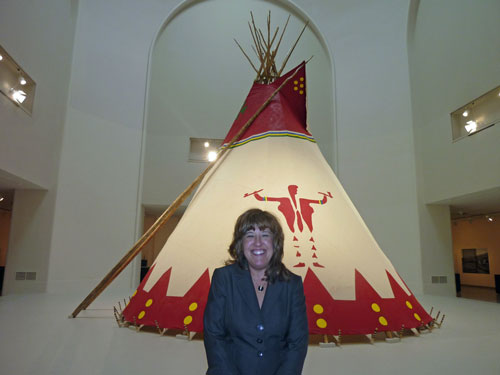
Nancy Rosoff, co-curator of the Brooklyn Museum's "Tipi: Heritage of the Great Plains," in front of Lyle Heavy Runner's "Blackfeet Tipi," 2010, commissioned for the show
Have you ever read a review of an exhibition that you've just seen, and felt as if you and that critic couldn't possibly have attended the same show?
That's how I felt after reading Ken Johnson's New York Times review of the Brooklyn Museum's Tipi: Heritage of the Great Plains exhibition (to May 15). Published on the same day as my own Wall Street Journal article on American Indian installations at several museums (including Brooklyn), Johnson's critique seemed to me so perplexingly off-kilter that I felt the need to present an alternate view.
Let's cut to the chase: I loved this show!
As I mentioned in my WSJ article, I, like Johnson, was jarred by the disconnects between great historic masterpieces and some (but not all) of the contemporary works, which, to me, don't measure up to their antecedents. This was a problem for me not just in Brooklyn, but also in the Denver Art Museum's new permanent-collection installation.
But Johnson wrong-footed his review from the start, by putting the "kitsch"...
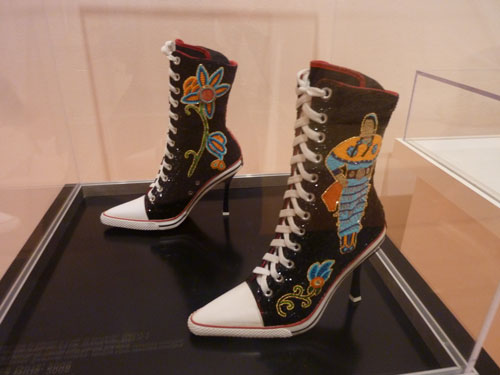
Teri Greeves, Kiowa, "Great Lakes Girls," 2008, Brooklyn Museum
...before the horse:
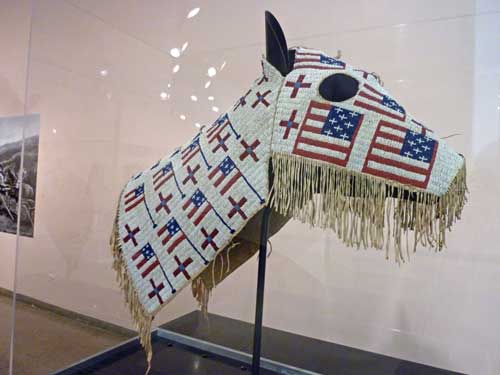
Horse Mask, Teton Sioux, ca. 1900, Thaw Collection, Fenimore Art Museum, Cooperstown, NY
Johnson did admit that Brooklyn's show featured an "outstanding selection of mostly 19th-century works of art and craft," which he regarded as "uniformly first-rate." But from his downbeat first paragraph to his condescending conclusion, he left an overall negative impression about the show's worth.
By contrast, I found this show a pleasure to peruse, because co-curators Nancy Rosoff and Susan Kennedy Zeller resourcefully wrangled superlative examples from a wide variety of sources. Rosoff said that she had deliberately sought objects that were not well known or previously published. (The show's catalogue rectifies this neglect.) While Johnson asserted in his review that most of the historic material came from Brooklyn's own collection, Rosoff had informed me during the press preview that only about half the exhibition came from her institution's holdings.
I do have to concede that I was taken aback that the first major object encountered in the show is that big garish tepee pictured at the top of this post. But it does serve a useful purpose: Children can enter it for Indian story-telling, while also learning about proper tepee etiquette:
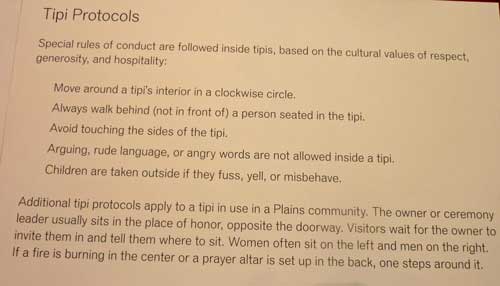
Maybe parents should try to get their kids to pretend that they're still in the tepee when they get back home!
But if Johnson noticed during his visit that the show includes not only modern knock-offs, but also a fine historic tepee (embellished with beaded medallions and, on the back, with beaded panels), he neglected to mention that to his readers:
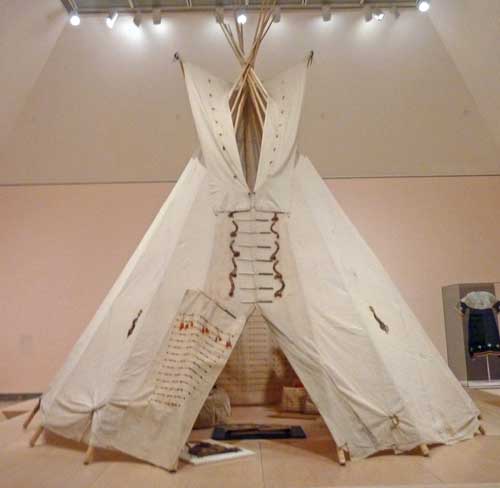
Tepee, Southern Cheyenne, ca. 1904, Milwaukee Public Museum
Within this canvas enclosure, the curators did a bit of interior decorating, installing backrests and pillows, ca. 1904, also from Milwaukee's collection, and (in the foreground) a parfleche (flat, envelope-like container), ca. 1900, from Brooklyn's holdings:
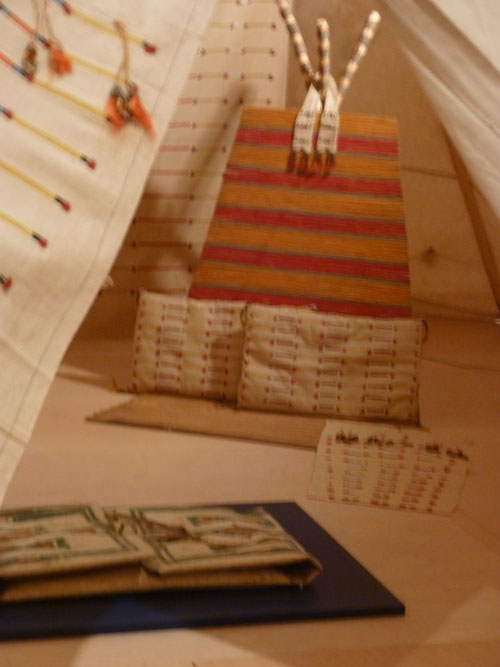
What I found hardest to understand about the Times critic's review were his assertions that Brooklyn's show "speaks down to its audience, assuming a low level of sophistication" and that it "offers no revelatory perspective on its [the show's] contents."
I'll concede that Ken's ken may exceed mine and that, as he says, some of the information (i.e., tepees aren't wigwams) will be old news to the old hands. But quite a few of the labels were revelatory to me and, I suspect, would be to many (if not most) visitors. One example was the information provided about what were perhaps my favorite objects in the show---the Brooklyn Museum Collection's lavishly embellished shirt for a chief's war dress, with warrior leggings, both Yanktonai, early 19th century, from Fort Snelling, Minnesota:
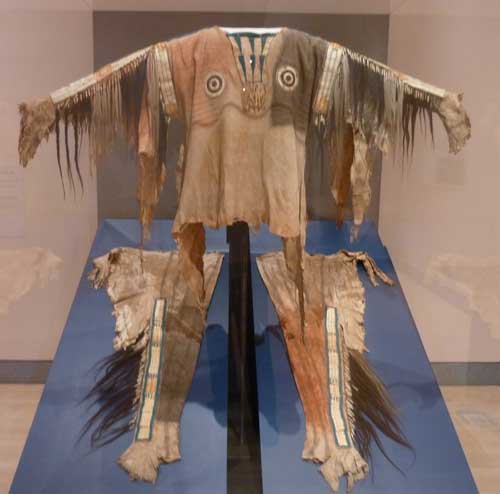
Here's a side view of that shirt's sleeve, which gives you some sense of its intricate composition of buckskin, pony beads, porcupine quills, maidenhair-fern stems, human hair, horsehair, dye and feathers.
The label informs us:
The shirt's painted designs probably represent war exploits: Single lines are stylized rifles, bifurcated lines are quirts (riding whips), the abstract triangular torsos with faceless heads on the back of the garment might indicate coups, and the horse tracks on the right sleeve indicate successful horse raids.
Similarly fascinating to me was the label explicating this cradle:
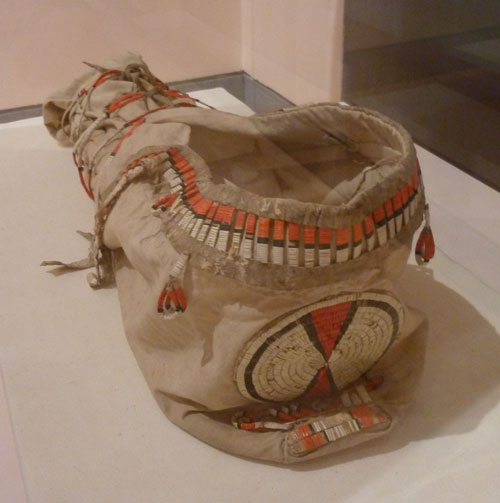
Cradle, Arapaho, 1870s, Brooklyn Museum
Here's the deeply informative text:
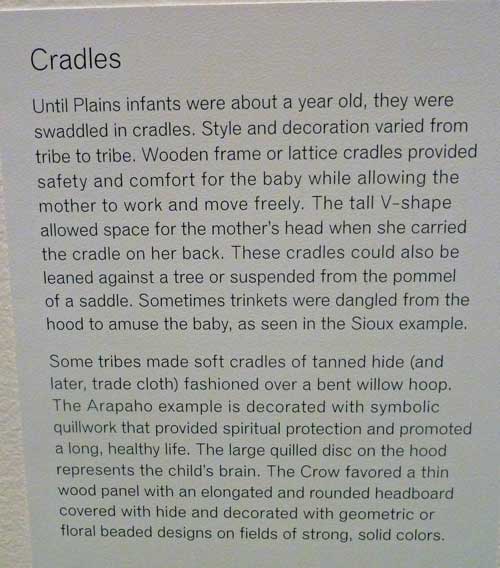
Particularly child-friendly was the assortment of dolls and games towards the end of the show. Below, composed of bones, wood and feathers, is an Arikara ice glider set, ca. 1920, from the National Museum of the American Indian:

The "Games" label informs us that "boys and girls tossed ice gliders across frozen rivers and lakes to see whose glider could go farthest with the greatest accuracy" (like when I played skully with bottlecaps on the Bronx sidewalks).
Having previously been transfixed by the Nelson-Atkins Museum's celebrated Arikara shield on buffalo rawhide of a buffalo bull...
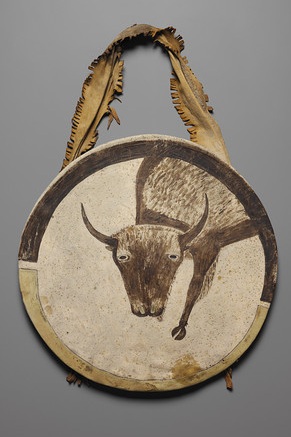
Arikara Shield, ca. 1850, Nelson-Atkins Museum of Art. Photo courtesy of Nelson-Atkins Museum of Art
... I was of course disappointed that Brooklyn had to fall back on a newly created substitute, because tribal consultants had objected to displaying historic objects (like shields) that were imbued with a warrior's power:
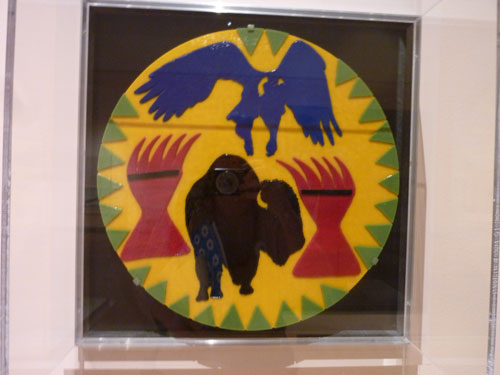
Marcus Amerman, Choctaw, "Rain-in-the-Face Shield," 2009-10, private collection
Facing this glass "shield," on the opposite wall, was the image of a historic shield, proudly borne by the actual Rain-in-the-Face, a Lakota warrior:
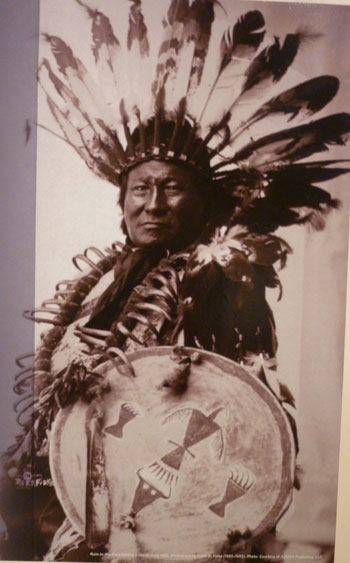
One of the standouts in Brooklyn's show is a rare cotton tepee liner, 1889, painted by Rain-in-the-Face and densely decorated with the visual vignettes of his exploits. Here's one small detail of this nearly 17-foot-long epic:
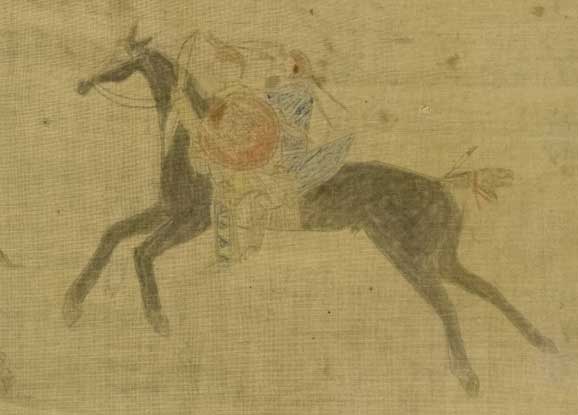
Rain-in-the-Face, Húnkpapa Lakota, Tepee Liner (detail), 1889, Standing Rock Reservation, ND, Brooklyn Museum Collection. Photo courtesy of Brooklyn Museum
In a series of text panels, the curators narrate the various episodes illustrated, including the one above:
This scene may relate to an incident in which Rain-in-the-Face is said to have saved the daughter of the Upper Yanktonai Black Prairie Dog by extending his quirt to her and swinging her up onto his horse when their camp was attacked by the U.S. Army.
Tribal consultants also restricted Brooklyn's display of pipes: They could only be shown disassembled, because "putting the bowl and stem together activates the power of the pipe," Rosoff told me.
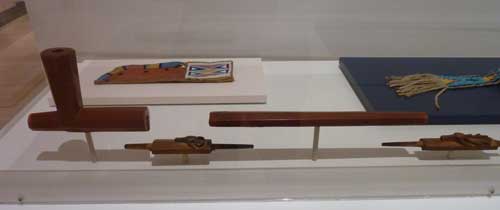
Pipe, Oglala, 1850-90, Brooklyn Museum
What bothered me most about this show was that it won't travel. In response to my query, Rosoff told me that "Tipi Heritage" was originally supposed to tour: "We had three [museums] lined up, and one had made a deposit," she told me. But because of "tough financial times, they couldn't finance an exhibition of this scale."
That's too bad. I believe that this beautifully conceived, expertly installed exhibition should be more widely seen. Maybe Rosoff's next show will have better luck: She'll be focusing on Andean textiles.
All photos, unless otherwise noted, by Lee Rosenbaum